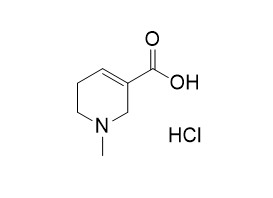Arecaidine hydrochloride
Arecaidine hydrochloride may have carcinogenesis.
Inquire / Order:
manager@chemfaces.com
Technical Inquiries:
service@chemfaces.com
Tel:
+86-27-84237783
Fax:
+86-27-84254680
Address:
1 Building, No. 83, CheCheng Rd., Wuhan Economic and Technological Development Zone, Wuhan, Hubei 430056, PRC
Providing storage is as stated on the product vial and the vial is kept tightly sealed, the product can be stored for up to
24 months(2-8C).
Wherever possible, you should prepare and use solutions on the same day. However, if you need to make up stock solutions in advance, we recommend that you store the solution as aliquots in tightly sealed vials at -20C. Generally, these will be useable for up to two weeks. Before use, and prior to opening the vial we recommend that you allow your product to equilibrate to room temperature for at least 1 hour.
Need more advice on solubility, usage and handling? Please email to: service@chemfaces.com
The packaging of the product may have turned upside down during transportation, resulting in the natural compounds adhering to the neck or cap of the vial. take the vial out of its packaging and gently shake to let the compounds fall to the bottom of the vial. for liquid products, centrifuge at 200-500 RPM to gather the liquid at the bottom of the vial. try to avoid loss or contamination during handling.
Biochem Systematics and Ecology2017, 11-18
Korean Herb. Med. Inf. 2016, 4(1):35-42
ACS Pharmacol Transl Sci.2024, 7(2):395-405.
Int J Mol Sci.2024, 25(16):8846.
Microchemical Journal2014, 203:110804.
Prev Nutr Food Sci.2025, 30(1):92-100.
Evid Based Complement Alternat Med.2018, 2018:4580627
Cancers (Basel).2021, 13(9):2223.
Molecules.2023, 28(13):4971.
Earth Environ. Sci. 2021, 905:012080.
Related and Featured Products
Biochem J. 1971 May;122(4):503-8.
The metabolic interconversion of arecoline and arecoline 1-oxide in the rat.[Pubmed:
5123883 ]
METHODS AND RESULTS:
1. Tritiation of arecoline hydrochloride by catalytic exchange in aqueous media (done by The Radiochemical Centre) gave Arecaidine hydrochloride of high specific radioactivity; this on treatment with diazomethane gave [(3)H]arecoline, which was oxidized with peroxyacetic acid to [(3)H]arecoline 1-oxide. 2. Arecoline 1-oxide gave arecaidine 1-oxide on acid hydrolysis and 1,2-dihydro-1-methylnicotinic acid methyl ester on thermal decomposition.
3. [(3)H]Arecoline hydrochloride was metabolized in the rat into the (3)H-labelled derivatives of arecoline 1-oxide, arecaidine 1-oxide, arecaidine, N-acetyl-S-(3-carboxy-1-methylpiperid-4-yl)-l-cysteine and an unidentified metabolite; some unchanged arecoline was also excreted.
CONCLUSIONS:
[(3)H]Arecoline 1-oxide gave the same metabolities, but in different amounts. 4. The possible relevance of these findings to betel-nut carcinogenesis is discussed.



